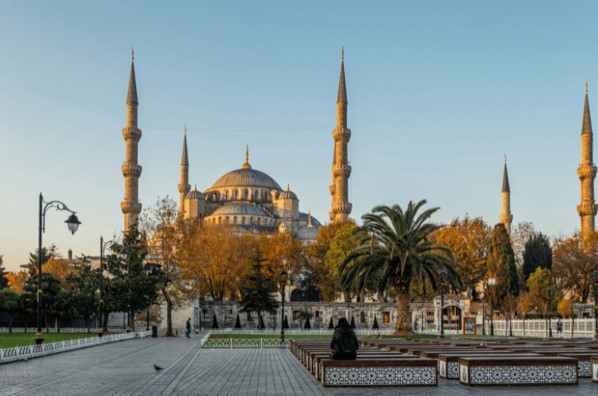(CNN) — Ah Italy, the land of pizza, pasta and plenty of tomato sauce. At minimum, which is the impression numerous site visitors have when organizing a excursion to the Bel Paese. But if they are setting up to visit preferred vacationer web pages like Cinque Terre or Portofino, they could be in for a shock — simply because the traditional food items of Liguria, the northwest coastal area in which both are situated, is considerably from what outsiders may well contact “Italian.”
The place other locations of Italy have regular dishes that are what we’d identify as “Italian” food, conventional Ligurian dishes are somewhat diverse.
Of program, there is certainly pasta with pesto. But there are also dishes like farinata, a form of chickpea pancake that’s salted and served in slices, and cappon magro, a “salad” of seafood and cooked greens, slathered in basil-significant environmentally friendly sauce, commonly served in an elaborate pile that makes it appear like a dish established for a banquet.
As for tomatoes? You uncover them pepping up the odd stew or sauce but they are not front and centre as they are in our imaginings of “Italian” food stuff.
That is partly down to the point that Italy’s meals scene is extremely regional, with substantial variation even from city to town. But, say experts, which is not the only explanation.
A really like of tradition — maybe much too considerably

Liguria is a land of steep cliffs and mountains which are terraced to grow meals and wine.
Vivida Photograph Pc/Adobe Inventory
Instead, he claims, it is additional likely to be the “traditionalist” and “closed” mother nature of the Ligurians — despite regional money Genoa acquiring been one of the most crucial ports and trading hubs of the Mediterranean. “Ligurians were being the biggest traders but [new ingredients] did not essentially enter into their recipes,” he states. “The Genoese are reserved, tending to family intimacy and local community. In the previous, variations had been often noticed with a sure diffidence, primarily by the doing work and center classes — as took place with the introduction of ingredients from the New Environment.” While the Genoese have a extensive history of building and ingesting pasta — there’s a doc from 1244 which references it — they simply “never ever hit on tomato as a condiment.”
In truth, states Rossi, the arrival of the potato was “significantly more important” than that of the tomato. Potatoes gave the men and women of the entroterra — the hilly, mountainous inland regions populated by contadini (peasants) — a reputable food items that held them alive.
While even then, that Ligurian tradition-loving mother nature didn’t make it quick. The potato was noticed as a “chic issue” from abroad, he claims — so by the 18th century, whilst the Genoese aristocracy ended up fortunately feasting on French-style potato dishes, rural communities ended up mistrustful. The Catholic church experienced to action in, with regional monks convincing their parishioners that potatoes were being safe to try to eat as late as 1786. The humble spud would ultimately “transform the life” of farmers and laborers, claims Rossi. But tomatoes did not. “They do not fill the belly — so they would never be a basic ingredient,” he claims.
Rossi says that it was only in the 19th century that tomato sauce turned a feasible mass-market and operating class foods, thanks to conservation solutions this sort of as canning.
“Which is when it entered into dishes — in some cases pasta but also stews, like minestrone Genovese and stockfish stew. The Ligurians created a tomato sauce.”
‘A secretive part of Italy’

Usual food items like focaccia were being introduced in advance of tomatoes arrived in Italy.
Magdalena Bujak/Adobe Stock
Even though foreigners associate Italian food stuff with tomatoes, in simple fact they are a somewhat current introduction to the state.
By the time it was, Liguria’s world-popular dishes like pasta with pesto, focaccia and farinata ended up presently entrenched.
And the place other regions included tomatoes in their signature dishes — “I am often shocked when I go to Tuscany how much tomato they use in dishes that in all probability have [pre-tomato] medieval origins,” states Zancani — Ligurians did not. Like Rossi, he places that down to the cultural isolation.
“Liguria has generally been a really secretive section of Italy — Genoa had contact with the rest of the earth since of their ships, but a great deal of the relaxation is very isolated,” he claims.
“It is really a mainly mountainous area, so traditions are saved much for a longer period than other sites. In any rural area, you can find a large amount of conservatism — points were being stored for centuries without having a great deal transform.”
On the menu: medieval foodstuff

Genoa is regarded for its “friggitorie,” or fried fish stands.
maudanros/iStock Editorial/Getty Images
For Monzani, the absence of tomatoes in Ligurian food is not really a lack — fairly, it truly is a sign of Liguria’s vegetable-significant cuisine that usually means there’s no home for a star of the display.
Of course, veg-heavy. Because whilst we believe of Liguria as a coastal desired destination, in fact, seafood only entered the canon of Ligurian cooking when tourism took off in the 1900s, she claims. As a substitute, Ligurians have usually terraced the cliffsides and mountains to mature vegetables, and sourced components like mushrooms in the forested hills and mountains inland — then extra issues like anchovies throughout the summer season period. Friggitorie — actually “frying retailers” — have also been popular in Genoa since the Middle Ages, serving battered small fish as well as fried ravioli, panisette (like outsized chickpea fries) and frisceu (deep-fried dough balls).
“Our classic cuisine is based on veggies or products from the woods — chestnuts, potatoes, mushrooms and herbs — it is really linked to farmers and peasants additional than to fishermen,” she claims. She even has a segment of her website committed to “wild herbs and flowers” recipes.
What’s much more, tomato-sauced pasta was by no means likely to capture on in a region which experienced devised its main pasta toppings in the medieval period, she states.
“It’s classic for us to season pasta with uncooked sauces: pesto, walnut sauce, pine nut sauce — there is certainly a great sauce of marjoram and pine nut,” she says.
An eastern affect

As 1 of the Mediterranean’s most important ports, Genoa had speak to with numerous other cultures.
Anatolii Lyzun/Adobe Stock
Liguria’s tradition of uncooked, nut-centered pasta sauces dates back again to the Muslim and Arabic affect of the medieval period, suggests Monzani, sparked by Genoa’s status as a person of the most critical ports in the Mediterranean. Saracen pirates also made incursions alongside the coastline. The consequence? “In the early Middle Ages we launched nuts into our cuisine.”
Basil is imagined to have arrive from the east, far too, says Rossi. “It’s not quick to say how it arrived but for hundreds of years Genoa was the most significant port in the Mediterranean — it is clear that if an component arrived, it’d arrive below.
Pesto is derived from agliata, a loved ones of garlic-hefty medieval sauces, he suggests. Even though other areas of Italy did have basil, it was the Ligurians who put together it with nuts, garlic and parmesan. The simple fact that the Ligurians previously experienced pasta — they’ve produced it for 800 years and traded it for a little extended — was “elementary,” he states. Pesto was already cited as the condiment for pasta on giorni di magro — meat-free of charge times imposed by the Catholic church — in 1618.
Modern specials: wild herbs and rose syrup

“Prebuggiun” is a combine of wild herbs or greens.
A Small Kitchen in Genoa
The Ligurian enjoy of greens goes outside of what we might find in the grocery store. There’s a prolonged custom right here of consuming wild herbs and even flowers — syrup built from pressed rose petals is a will have to-have summer months solution. Currently, prebbugiun is a blend of any regional herbs eaten in a soup, salad, pie or frittata (omelet-model dish) states Rossi the identify derives from “prebollire” or “sbollentare” — to parboil or blanch. Although currently it refers primarily to wild herbs, in the 19th century, recipes and dictionaries mentioned cabbage, chard, parsley and other herbs as ingredients. Even today, in the valleys outdoors Genoa, he says, it can take the type of cabbage, potatoes and garlic, parboiled and served with oil as an appetizer.
Zancani suggests that a great deal Ligurian cuisine “is dependent on peasant foodstuff, specially on the awareness of wild herbs.”
“They have many concoctions which rely on distinct wild herbs that can only be identified in the hills and mountains of Liguria,” he claims.
And of training course, as Rossi reiterates, foods in Italy is highly regional, typically not even by area but commonly by city, valley or village. “It is like a significant mosaic — stunning, but we need to seem at just about every stone producing it up,” he suggests. “We have traditional cooking by regions, villages and even family members.
“Italian meals isn’t going to exist — at minimum, not in Italy.”




More Stories
Top 5 Cafe around Sudirman Worth a Visit
KC named one of the best places in America to travel
At Urban Hawker in New York, Singapore street food gets a new HQ